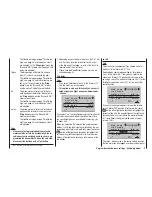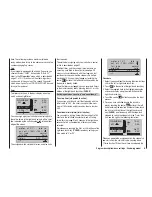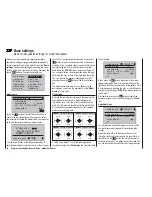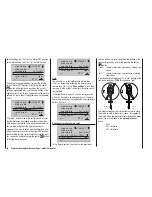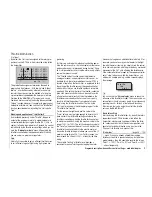
70
Program description: base settings - model helicopter
rx bind
(
Bound receiver)
Graupner
HoTT receivers have to be “instructed” to
communicate exclusively with a particular model (i. e.
model memory) of a
Graupner
HoTT transmitter. This
process is known as “binding”, and is only necessary
once for each new combination of receiver and model.
Important note:
When carrying out the binding procedure, please
ensure that the transmitter aerial is always an
adequate distance from the receiver aerials: keeping
the aerials about 1 m apart is safe in this respect.
Otherwise you risk a failed connection to the down-
link channel, and consequent malfunctions.
“Binding” multiple receivers to one model
If necessary, it is possible to bind more than one re-
ceiver to a single model. This is accomplished by initially
binding the receivers individually, as described in the
next section.
When operating the system, please note that only
the receiver which was bound last will establish a
telemetry link to the transmitter.
For this reason all te-
lemetry sensors installed in the model must be connect-
ed to this receiver, since only the last bound receiver
is able to transmit their data via the down-link channel.
The second, and all other receivers, run in parallel to
the receiver last bound to the transmitter, but completely
independently of it; they operate in Slave mode with the
down-link channel switched off.
“Binding” transmitter and receiver
Use the arrow buttons
cd
of the left or right-hand
touch-key to move to the “rx bind” line:
phase 2
phase 3
hover
speed
5
4
autorotat.
2
receiv out
rx bind
–––
If you have not already done so, switch on the power
supply to your receiver now: the red LED on the receiver
fl ashes.
Press and hold the
SET
button on the receiver until,
after about three seconds, the red-fl ashing LED starts to
fl ash red / green; this will last for a further three seconds.
You can now release the
SET
button on the receiver.
The receiver is in Bind mode as long as the LED fl ashes
red / green.
Briefl y touch the central
SET
button of the right-hand
touch-key within this period of about three seconds:
this initiate the binding process between a receiver and
the current model memory. At the same time the word
“BINDING” starts fl ashing in the frame of the “rx bind”
line on the screen, instead of the three “---”:
phase 2
phase 3
hover
speed
5
4
autorotat.
2
receiv out
rx bind
BINDING
The receiver LED is now fl ashing red again, and if it
goes out within about ten seconds, and instead glows
a constant green, then the binding process has been
completed successfully. Your model / receiver combina-
tion is now ready for use. In parallel with this the screen
displays the code number for the receiver now “bound”
to this model memory. For example:
phase 2
phase 3
hover
speed
5
4
autorotat.
2
receiv out
rx bind
R08
If, in contrast, the red LED on the receiver fl ashes
for longer than about ten seconds, then the binding
process has failed. In parallel with this the screen will
display three “---” once more. If this should occur, alter
the relative position of the aerials and repeat the whole
procedure.
Range test
The integral range-check reduces the transmitter’s output
power in such a way that you can test the system’s
operation at a distance of up to about fi fty metres.
Carry out the range-check of the
Graupner
HoTT system
in accordance with the following instructions. We recom-
mend that you ask a friend to help with range-checking.
Install the receiver in the model as required, prefer-
1.
ably after completing the binding process with the
transmitter.
Switch the radio control system on and wait until the
2.
green LED on the receiver glows. Now you can ob-
serve the servo movements.
Place the model on a fl at surface (paving, close-mown
3.
grass or earth), with the receiver aerials at least 15
cm above the ground. This means that you may have
to place the model on a raised object for the period of
the check.
Summary of Contents for mx-16 HOTT
Page 7: ...7 For your notes...
Page 37: ...37 For your notes...
Page 41: ...41 For your notes...
Page 45: ...45 For your notes...
Page 51: ...51 For your notes...
Page 55: ...55 For your notes...
Page 81: ...81 For your notes...
Page 103: ...103 For your notes...
Page 133: ...133 For your notes...
Page 141: ...141 For your notes...
Page 161: ...161 For your notes...
Page 173: ...173 For your notes...


